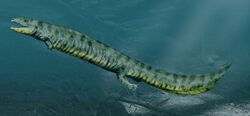Biology:Pholiderpeton
| Pholiderpeton | |
|---|---|

| |
| Restoration | |
| Scientific classification | |
| Domain: | Eukaryota |
| Kingdom: | Animalia |
| Phylum: | Chordata |
| Order: | †Embolomeri |
| Family: | †Eogyrinidae |
| Genus: | †Pholiderpeton Huxley, 1869 |
| Type species | |
| Pholiderpeton scutigerum Huxley, 1869
| |
| Other species | |
| |
Pholiderpeton (from Greek: φολῐ́δος Script error: The function "transl" does not exist., 'horny scale' and Greek: ἑρπετόν Script error: The function "transl" does not exist., 'creeping thing') is an extinct genus of embolomere amphibian which lived in the Late Carboniferous period (Bashkirian) of England. The genus was first named by Thomas Henry Huxley in 1869 to include the species P. scutigerum, based on the disarticulated front half of a skeleton discovered near Bradford, Yorkshire. Associated fossil wood suggests that this specimen died inside a Lepidodendron tree trunk.[1]
In 1987, Jennifer A. Clack suggested that a different embolomere, Eogyrinus attheyi from Newsham, Northumberland, belonged to the same genus as Pholiderpeton. She subsumed the genus Eogyrinus into Pholiderpeton and created the new combination P. attheyi.[1] The anatomy of "Eogyrinus" attheyi has been described in detail by A.L. Panchen.[2][3] Some phylogenetic analyses, such as those by Marcello Ruta & Michael Coates (2007) and David Marjanović & Michel Laurin (2019), have argued that Pholiderpeton scutigerum and "Eogyrinus" attheyi were not closely related to each other. However, neither publication reinstated the genus Eogyrinus.[4][5]
Pholiderpeton scutigerum measured 2 metres (6 ft 7 in) in length, while specimens of P. attheyi had 41 centimetres (16 in) long skull[3] and could measure up to 4.6 metres (15 ft) long. The latter species was thus among the largest Carboniferous tetrapods, and perhaps one of the largest of its family, the Eogyrinidae.[6]
References
- ↑ 1.0 1.1 Clack, J.A. (1987). "Pholiderpeton scutigerum Huxley, an amphibian from the Yorkshire coal measures". Philosophical Transactions of the Royal Society of London B: Biological Sciences 318 (1188): 1–107. doi:10.1098/rstb.1987.0082.
- ↑ Panchen, A. L. (1966). "The axial skeleton of the labyrinthodont Eogyrinus attheyi" (in en). Journal of Zoology 150 (2): 199–222. doi:10.1111/j.1469-7998.1966.tb03004.x.
- ↑ 3.0 3.1 Panchen, A. L. (10 February 1972). "The skull and skeleton of Eogyrinus attheyi Watson (Amphibia: Labyrinthodontia)" (in en). Phil. Trans. R. Soc. Lond. B 263 (851): 279–326. doi:10.1098/rstb.1972.0002. ISSN 0080-4622.
- ↑ Ruta, M.; Coates, M.I. (2007). "Dates, nodes and character conflict: addressing the lissamphibian origin problem". Journal of Systematic Palaeontology 5 (1): 69–122. doi:10.1017/S1477201906002008.
- ↑ Marjanović, D.; Laurin, M. (2019). "Phylogeny of Paleozoic limbed vertebrates reassessed through revision and expansion of the largest published relevant data matrix". PeerJ 6 (e5565): 1–191. doi:10.7717/peerj.5565. PMID 30631641.
- ↑ Palmer, D., ed (1999). The Marshall Illustrated Encyclopedia of Dinosaurs and Prehistoric Animals. London: Marshall Editions. p. 53. ISBN 1-84028-152-9.
Wikidata ☰ Q596350 entry
 |

